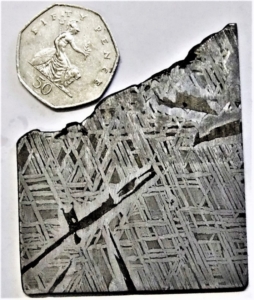Article by Dr Fred Starr PhD, FIMMM, FIE, MIMechE, CEng
In an earlier posting I mentioned the barely explicable Widmanstatten structure, seen in the iron-nickel Marburg meteorite, which was found by local people as result of Alfred Wegener offering a reward. Although a good deal is known about the Widmanstatten pattern or structure, I want to explain, why, in my view, there are some unanswered questions.

Etched section from part of a meteorite discovered near Muonionalusta, northern Sweden
To see the Widmanstatten structure one must take a slice from the meteorite, grind and polish the surface so it gleams like a mirror, and then gently etch it using a weak solution of nitric acid, dissolved in alcohol. The underlying structure is then visible to the naked eye. It has the appearance of a pattern consisting of fine strips of paper laid on top of one another. Sometimes the strips are at right angles. Other times they can be at 30° or 60°.
The German Professor, Fritz Heide, published the “Kleine Meteoritenkunde” in 1934, one of the first books on meteorites. It was subsequently brought up to date by Frank Wlotzka and translated into English in 1994. Although missing more recent accounts of meteor phenomena, and in situ investigations of the asteroids and planets, it remains one of the standard works on the subject. Nevertheless, this book, and what I have read on the internet, doesn’t really tell us where Widmanstatten meteorites come from. Heide and Wlotzka were more interested in the stony meteorites, that are much more common.Continue reading full article…

Boos, boosts and booze infuse German news – English word boostern wins a prize
/in Deutsch, Language, News /by HE TranslationsThe English verb to boost means to assist or encourage something to grow or rise, and also serves as a noun meaning something which, usually deliberately, helps something else increase or rise. So the space race saw the introduction of booster rockets, and child car safety regulations saw the introduction of booster seats to raise small children to the minimum height for safety belts. But boosting also has a more political and ambiguous dimension dating to nineteenth century North America, yet resonating in the scandals in the UK in 2022.Continue reading full article…
What is agile today ?
/in Language, Neologisms, Technical /by HE TranslationsHow agile are you? Or rather, how agile is your company, and what does that mean today if you are not professional steeplejacks? It is curious how this term became such a ubiquitous buzzword, as some find themselves thinking they need to race to catch up with a speeding trend, rather than risk being left behind and seen as clumsy or unbalanced.
A Management Today Words-Worth piece by John Morrish examined the question and indeed the word itself:Continue reading full article…
Ode to Yorkshire
/in News /by HE TranslationsYORKSHIRE – IT’S GRADELY!
A guest blogpost from Anne Hayto, folk music enthusiast and co-founder & Secretary of the Aylestone Meadows Appreciation Society
When planning holidays, as a Yorkshire lass born and bred, my thoughts usually turn northwards and this year it was an August week in Whitby, mingling with the scarily dense crowds of people who obviously had the same idea as me. What is it that brings people back time and again to the lands of their birth and childhood? I grew up in Wakefield, once part of the West Riding, but I left there in my early twenties to seek a life away from ‘the dark satanic mills’. I’ve spent most of the rest of that life wishing I had returned, but of course, the mills are now apartments and the coal mines which surrounded my home town are no more. I have remnants of family still in Wakefield, but most of them are gone now. Yet still I return even though I’m a stranger in the old town.Continue reading full article…
Robert Bunsen – his burner and its impact on the gas industry
/in Science, Technical /by HE TranslationsA Bunsen burner
Article by Dr Fred Starr PhD, FIMMM, FIE, MIMechE, CEng
When thinking of key German Scientists, I recollect our Chemistry Lab, at my school in Stockton-on-Tees, where adorning the polished benches, was, in a sense, the greatest of all scientific devices, a set of Bunsen burners. Artifact of every Mad Scientist movie. The first real job for our aged, silvery haired, and distinguished Chemistry master, Mr Dee, was to show us how this amazing device worked. When the slider was closed, flame was luminous and wafted around in a lazy manner. True magic came with the opening of the slider, when the burner was noisier, and although now a transparent blue, was obviously hotter. “Never allow the flame to light back” he proclaimed. “The gas that’s produced will kill you!”
Continue reading full article…
Home office or work from home?
/in Deutsch, Neologisms, Translation /by HE TranslationsThoughts on working from home and the term ‘home office’, by HE Translations director Herbert Eppel
Like many language service providers, I have been working from home for many years now, as described in the Leicester Mercury article from 2009 under the heading “Home work – we love it!”, which is available for your delectation here. Although the article didn’t foresee corona, it could perhaps be regarded as rather prescient in that it described a growing trend towards home working and envisaged a future in which this could become the norm, rather than an exception.
During the corona pandemic the term Homeoffice (alternative spelling: Home-Office) found its way into the standard German Duden dictionary – see here. Intriguingly, and perhaps mildly entertainingly, when Germans say or write Homeoffice, more often than not they refer to the activity (e.g. “ich mache Homeoffice“, literally translated as “I am doing home office” but indicating “I am presently working from home”), rather than a physical space.
Continue reading full article…
Naming that indescribable ache to be somewhere else: Fernweh in days of lockdown
/in Humour, Language, Neologisms /by HE TranslationsDreaming of faraway lands
Many of those locked away in long days of lockdown feel an indescribable ache to be someplace else, not just anywhere, somewhere nice and new and interesting. The German language already has a precise word for that aching far away feeling, and the German word has lately been been filling a void in the English language: Fernweh.
Fernweh isn’t just a case of “Get me out of here” or “Beam me up Scotty” or a desire to be nowhere at all, it’s a longing for faraway places that erase the ache and relieve the longing, and so the word is used in German travel adverts and even printed prominently on brands of activity clothing.Continue reading full article…
Widmanstatten meteorites
/1 Comment/in Translation /by HE TranslationsArticle by Dr Fred Starr PhD, FIMMM, FIE, MIMechE, CEng
In an earlier posting I mentioned the barely explicable Widmanstatten structure, seen in the iron-nickel Marburg meteorite, which was found by local people as result of Alfred Wegener offering a reward. Although a good deal is known about the Widmanstatten pattern or structure, I want to explain, why, in my view, there are some unanswered questions.
Etched section from part of a meteorite discovered near Muonionalusta, northern Sweden
To see the Widmanstatten structure one must take a slice from the meteorite, grind and polish the surface so it gleams like a mirror, and then gently etch it using a weak solution of nitric acid, dissolved in alcohol. The underlying structure is then visible to the naked eye. It has the appearance of a pattern consisting of fine strips of paper laid on top of one another. Sometimes the strips are at right angles. Other times they can be at 30° or 60°.
The German Professor, Fritz Heide, published the “Kleine Meteoritenkunde” in 1934, one of the first books on meteorites. It was subsequently brought up to date by Frank Wlotzka and translated into English in 1994. Although missing more recent accounts of meteor phenomena, and in situ investigations of the asteroids and planets, it remains one of the standard works on the subject. Nevertheless, this book, and what I have read on the internet, doesn’t really tell us where Widmanstatten meteorites come from. Heide and Wlotzka were more interested in the stony meteorites, that are much more common.Continue reading full article…
Alfred Wegener: author of the theory of Continental Drift
/in Translation /by HE TranslationsArticle by Dr Fred Starr PhD, FIMMM, FIE, MIMechE, CEng
It was just a mention from our Welsh Geography master, in one of the better schools of Stockton-on-Tees, where, back in the 1950s, I first heard of what is now loosely called Continental Drift. It was also from this teacher that I learnt that there was a paper called the “Manchester Guardian”. The only paper you can trust, he affirmed. Since 1961, under its new name, “The Guardian” I have been buying this left wing rag ever since. His purchasing of the Guardian and his espousal of what was then a somewhat weird account of Earth’s geological history, suggests that my Geography master was in a small but thinking minority. He was also against nuclear power, when the rest of Britain was all for it!
It was years afterwards, when I took up a casual interest in geology and fossil collecting that I learnt that it was the German, Alfred Wegener who was behind the idea of Continental Drift. But learning about the geology of Britain, I was struck by the fact that that hundreds of millions of years ago this country was covered by deserts. If it was that hot, at 55 degrees north, what was it like at the equator, I wondered? Literally boiling hot??? Continental drift would explain it all, but why didn’t died in the wool, professional geologists ask such an obvious question, instead of rejecting the theory.
Continue reading full article…
Glugging glue wine as Christmas comes unstuck
/in Humour, Language, Neologisms /by HE TranslationsContinue reading full article…
Ludwig Prandtl 1875-1953 – The man behind the science of aerodynamics
/in News, Technical /by HE TranslationsArticle by Dr Fred Starr PhD, FIMMM, FIE, MIMechE, CEng
Ludwig Prandtl is shown next to the water channel which he used in his early boundary layer investigations.
Ever wondered why you have to brush the dust off a piece of furniture? Not being able to blow it away? And were you puzzled that golf balls are knobbly rather than smooth? Surely a smoother ball should be more streamlined, and fly further? Or when boarding a jumbo jet, asked yourself why do the wings have to be so long, almost to the point of being floppy? Wouldn’t square shaped wings, attached along the length of the fuselage, be more sturdy?
The man who supplied us with the answer to these questions, the last one, being at one time a state secret, was Ludwig Prandtl, the greatest of all German Aeronautical Scientists. And a great bunch they were. Prandtl was there at the start of the business, when, although Lilienthal had died in his glider experiments, and the Wright Brothers had flown, there was no clear idea what kept an aircraft in the air. No one, in fact, had any idea, how best to design the most important attribute of an aircraft, the wings.
Continue reading full article…